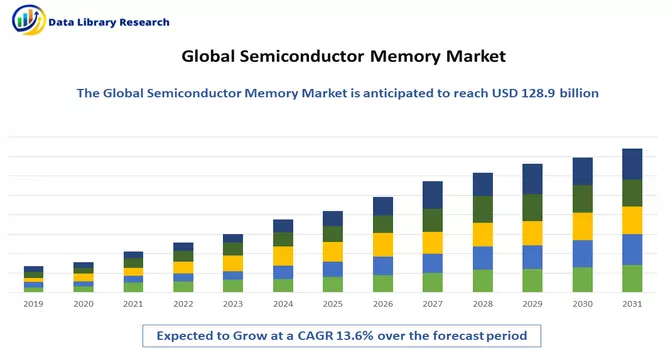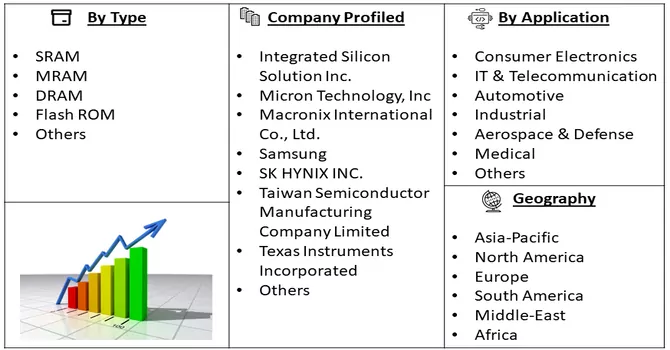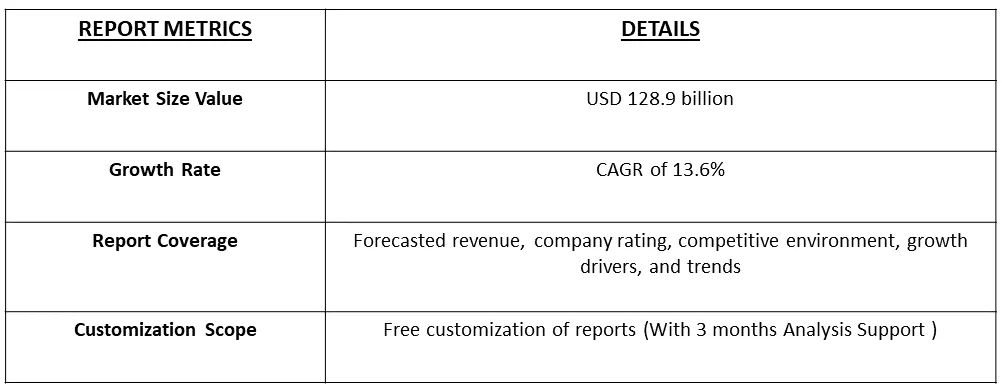The global semiconductor memory market size was valued at USD 128.9 billion in 2023 and is expected to grow at a compound annual growth rate (CAGR) of 13.6% from 2024 to 2031.

Get Complete Analysis Of The Report - Download Free Sample PDF
Semiconductor memory is a type of electronic data storage that utilizes semiconductor technology to store and retrieve digital information. It is a crucial component in modern computing systems, ranging from personal devices like smartphones and laptops to large-scale data centers. Unlike traditional forms of memory, such as magnetic or optical storage, semiconductor memory is characterized by its speed, durability, and non-volatile nature. The most common types of semiconductor memory include RAM (Random Access Memory) and ROM (Read-Only Memory). RAM is volatile memory used for temporary storage of data that the computer is actively using, while ROM is non-volatile and retains information even when the power is turned off, typically holding firmware or essential system instructions. Semiconductor memory technologies continue to evolve, with advancements like Flash memory and various types of DRAM (Dynamic RAM) enhancing storage capacity and performance in electronic devices. The versatility and efficiency of semiconductor memory have played a pivotal role in the rapid advancement of computing technology.
The market is set for substantial global growth, propelled by the increasing integration of semiconductor components across diverse industries such as automotive, consumer electronics, and IT & telecom. Functioning as essential electronic devices, these components operate as computer memory/chips, utilizing Integrated Circuit (IC) technology. The classification of these memories is based on their data storage and access methods, encompassing non-volatile ROM (Read Only Memory) and volatile RAM (Random Access Memory). With a rising demand for swifter, more reliable, and energy-efficient memory solutions, the market is anticipated to witness further expansion, presenting new opportunities for businesses within this sector.
Market Segmentation: The Semiconductor Memory Market is Segmented By Application (Consumer Electronics, IT & Telecommunication, Automotive; Industrial, Aerospace & Defense, Medical), and Geography (North America, Europe, Asia-Pacific, Middle-East and Africa, and South America). The report offers the value (in USD million) for the above segments.

For Detailed Market Segmentation - Download Free Sample PDF
The semiconductor memory market is witnessing notable trends is primarily fueled by the widespread adoption of semiconductor components across diverse industries, including automotive, consumer electronics, and IT & telecom. Another significant trend involves the evolving technology within semiconductor memory, with a focus on delivering faster, more reliable, and power-efficient memory solutions. As demands for enhanced performance and efficiency continue to rise, the market is experiencing a shift towards advanced memory technologies such as Flash memory and various types of DRAM (Dynamic RAM). Additionally, the market is witnessing a growing emphasis on non-volatile memory solutions like ROM (Read Only Memory), meeting the need for data retention even when power is turned off. These trends collectively indicate a dynamic and expanding semiconductor memory market, presenting opportunities for innovation and growth in the coming years.
Market Drivers:
Rise Of Data-Centric Applications, Cloud Computing, And Artificial Intelligence
The semiconductor memory market is experiencing a substantial boost driven by the rise of data-centric applications, cloud computing, and artificial intelligence (AI). As data becomes increasingly central to modern business operations, there is a growing demand for advanced semiconductor memory solutions capable of handling vast amounts of information with speed and efficiency. Cloud computing, which underpins the storage and processing of data on remote servers, relies heavily on semiconductor memory to ensure quick access and retrieval of information. Similarly, the rapid advancements in artificial intelligence, with applications ranging from machine learning to deep learning, necessitate sophisticated memory architectures to support the intense computational requirements. Semiconductor memory plays a pivotal role in optimizing the performance of AI algorithms by providing fast and reliable data storage and access. As the synergy between data-centric applications, cloud computing, and artificial intelligence continues to strengthen, the semiconductor memory market is poised for sustained growth, driven by the imperative need for memory solutions that can meet the escalating demands of these transformative technologies.
Increasing Requirements Of Data Storage, Processing Speed, And Energy Efficiency
The semiconductor memory market is witnessing a surge in demand propelled by the increasing requirements for data storage, processing speed, and energy efficiency across various industries. As the volume of data generated continues to skyrocket, there is a pressing need for advanced semiconductor memory solutions capable of accommodating large datasets while ensuring rapid and efficient data access. The demand for higher processing speeds is driven by applications such as artificial intelligence, machine learning, and real-time analytics, where quick and seamless data processing is crucial. Moreover, as energy efficiency becomes a paramount concern in the era of sustainability, there is a growing emphasis on semiconductor memory technologies that deliver optimal performance while minimizing power consumption. Innovations such as 3D stacking, non-volatile memory, and advanced fabrication processes contribute to meeting these evolving requirements. Semiconductor memory, playing a pivotal role in addressing the trinity of data storage, processing speed, and energy efficiency, stands at the forefront of technological advancements, driving the development of faster, more reliable, and power-efficient memory solutions to meet the escalating demands of our data-centric world.
Market Restraints:
The semiconductor memory market faces several restraints that pose challenges to its growth and development. One significant restraint is the cyclical nature of the semiconductor industry, which can lead to fluctuations in demand and oversupply situations, impacting market stability. Additionally, the complexity and high costs associated with the research, development, and manufacturing processes of advanced semiconductor memory technologies can act as barriers for smaller players, limiting their ability to compete in the market. Supply chain disruptions, geopolitical tensions, and trade uncertainties can also negatively impact the semiconductor memory market by affecting the availability of raw materials and hindering global trade. Furthermore, the increasing miniaturization of semiconductor components poses technical challenges, such as heat dissipation and reliability issues, which can impede the development of smaller and more powerful memory solutions. Intellectual property disputes and stringent regulatory requirements further add complexities to the market landscape. These restraints collectively underscore the intricate challenges that the semiconductor memory market faces as it strives to meet the demands of a rapidly evolving technological landscape.
The COVID-19 pandemic has exerted a significant impact on the semiconductor memory market, influencing various facets of the industry. The global disruptions caused by the pandemic, such as lockdowns, supply chain constraints, and decreased consumer spending, have led to both challenges and opportunities in the semiconductor memory sector. Initially, there were disruptions in production and supply chains, affecting the availability of critical components. However, as the demand for electronics and digital infrastructure surged during lockdowns, there was an increased need for semiconductor memory in devices like laptops, tablets, and data centers. This unexpected spike in demand presented a dual challenge and opportunity for the industry, requiring rapid adjustments to manufacturing processes to meet the increased need. Additionally, the pandemic underscored the importance of semiconductor memory in enabling remote work, online education, and digital connectivity. As the global economy gradually recovers, the semiconductor memory market is poised for growth, driven by ongoing digitization trends and the need for robust memory solutions in various applications.
Segmental Analysis:
IT & Telecommunication Segment is Expected to Witness Significant Growth over the Forecast Period
The symbiotic relationship between Information Technology (IT) and Telecommunication is integral to the seamless functioning of modern societies and businesses. In this dynamic landscape, semiconductor memory plays a crucial role in ensuring the efficiency and speed of information processing within IT and telecommunication systems. As these sectors continue to evolve and demand higher performance, semiconductor memory technologies have witnessed substantial advancements to meet the growing needs of data storage and access. In the IT sector, semiconductor memory is fundamental to the functioning of computers, servers, and other computing devices. Random Access Memory (RAM) enables swift data access, ensuring the rapid execution of applications and processes. Moreover, advancements in Flash memory technology have facilitated the development of high-capacity and fast storage solutions, such as Solid State Drives (SSDs), significantly enhancing data transfer speeds and overall system responsiveness. Telecommunication systems heavily rely on semiconductor memory for various applications, including network routers, switches, and communication infrastructure. Memory modules contribute to the quick retrieval and processing of data, optimizing the performance of telecommunication networks. Additionally, semiconductor memory is crucial in the development of advanced mobile devices, supporting the seamless operation of smartphones and ensuring smooth multitasking capabilities. The integration of semiconductor memory in IT and telecommunication not only enhances the speed and efficiency of data processing but also contributes to the overall reliability and responsiveness of these systems. As the IT and telecommunication sectors continue to expand, the demand for innovative semiconductor memory solutions is expected to rise, driving further advancements and shaping the technological landscape for years to come.
Asia Pacific Region is Expected to Witness Significant Growth over the Forecast Period
The Asia Pacific region holds a central role in the global semiconductor memory market, serving as both a significant consumer and a key manufacturing hub for semiconductor technologies. Countries such as China, Japan, South Korea, and Taiwan contribute substantially to the market, driven by rapid economic growth, technological advancements, and increasing demand for memory-intensive applications. China's push to become a global technology leader and its growing electronics market have spurred innovation and consumption. Japan, with its historical prowess in technology, continues to influence semiconductor memory advancements, while South Korea, home to major manufacturers, plays a crucial role in developing cutting-edge memory technologies. Taiwan, renowned for semiconductor fabrication expertise, contributes significantly to global memory chip production. Beyond consumption, the Asia Pacific region houses major manufacturing facilities and research centers, solidifying its position in the semiconductor memory supply chain. With the escalating demand for electronic devices and data storage, the Asia Pacific region is poised to play a pivotal role in shaping the future trajectory of the semiconductor memory industry.

Get Complete Analysis Of The Report - Download Free Sample PDF
The semiconductor memory market is predominantly influenced by a select group of leading companies, collectively commanding the largest market share and influencing industry trends. An in-depth analysis of the financials, strategic roadmaps, and product portfolios of these key players is undertaken to intricately map the supply network within the semiconductor memory sector. These companies play a pivotal role in shaping the direction of the market, as their market dominance is indicative of their significant contributions to technological advancements and innovation in the semiconductor memory industry. By closely examining the financial standing, strategic initiatives, and product offerings of these influential firms, a comprehensive understanding of the supply dynamics and competitive landscape within the semiconductor memory market is achieved.
Recent Development:
1) In February 2023, Texas Instruments Incorporated revealed plans to invest a substantial USD 11 billion in the establishment of its upcoming 300-mm semiconductor wafer fabrication plant in Utah, U.S. The strategic move was driven by the company's objective to bolster its manufacturing capacity in response to the escalating demand for semiconductors in the electronics sector. This investment aimed at fortifying Texas Instruments' position in the industry and meeting the surging market needs.
2) In a collaborative effort announced in November 2022, Infineon Technologies AG and Taiwan Semiconductor Manufacturing Company Limited unveiled a partnership focused on integrating the latter's Resistive RAM (RRAM) Non-Volatile Memory (NVM) technology into Infineon's AURIX microcontrollers. The joint initiative targeted the enhancement of microcontroller performance and the reduction of power consumption through the utilization of advanced RRAM technology. This strategic collaboration aimed to bring forth technological advancements, underscoring the commitment of both companies to innovation and efficiency in the semiconductor industry.
Q1. What was the Semiconductor Memory Market size in 2023?
The global semiconductor memory market size was valued at USD 128.9 billion in 2023.
Q2. What is the Growth Rate of the Semiconductor Memory Market ?
Semiconductor Memory Market is expected to grow at a compound annual growth rate (CAGR) of 13.6% over the forecast period.
Q3. What Impact did COVID-19 have on the Semiconductor Memory Market?
The COVID-19 pandemic has exerted a significant impact on the semiconductor memory market, influencing various facets of the industry. For more insghts request a sample here.
Q4. Which Region is expected to hold the highest Market share?
Asia-Pacific region is expected to hold the highest Market share.
Data Library Research are conducted by industry experts who offer insight on industry structure, market segmentations technology assessment and competitive landscape (CL), and penetration, as well as on emerging trends. Their analysis is based on primary interviews (~ 80%) and secondary research (~ 20%) as well as years of professional expertise in their respective industries. Adding to this, by analysing historical trends and current market positions, our analysts predict where the market will be headed for the next five years. Furthermore, the varying trends of segment & categories geographically presented are also studied and the estimated based on the primary & secondary research.
In this particular report from the supply side Data Library Research has conducted primary surveys (interviews) with the key level executives (VP, CEO’s, Marketing Director, Business Development Manager and SOFT) of the companies that active & prominent as well as the midsized organization
FIGURE 1: DLR RESEARH PROCESS

Extensive primary research was conducted to gain a deeper insight of the market and industry performance. The analysis is based on both primary and secondary research as well as years of professional expertise in the respective industries.
In addition to analysing current and historical trends, our analysts predict where the market is headed over the next five years.
It varies by segment for these categories geographically presented in the list of market tables. Speaking about this particular report we have conducted primary surveys (interviews) with the key level executives (VP, CEO’s, Marketing Director, Business Development Manager and many more) of the major players active in the market.
Secondary ResearchSecondary research was mainly used to collect and identify information useful for the extensive, technical, market-oriented, and Friend’s study of the Global Extra Neutral Alcohol. It was also used to obtain key information about major players, market classification and segmentation according to the industry trends, geographical markets, and developments related to the market and technology perspectives. For this study, analysts have gathered information from various credible sources, such as annual reports, sec filings, journals, white papers, SOFT presentations, and company web sites.
Market Size EstimationBoth, top-down and bottom-up approaches were used to estimate and validate the size of the Global market and to estimate the size of various other dependent submarkets in the overall Extra Neutral Alcohol. The key players in the market were identified through secondary research and their market contributions in the respective geographies were determined through primary and secondary research.
Forecast Model
